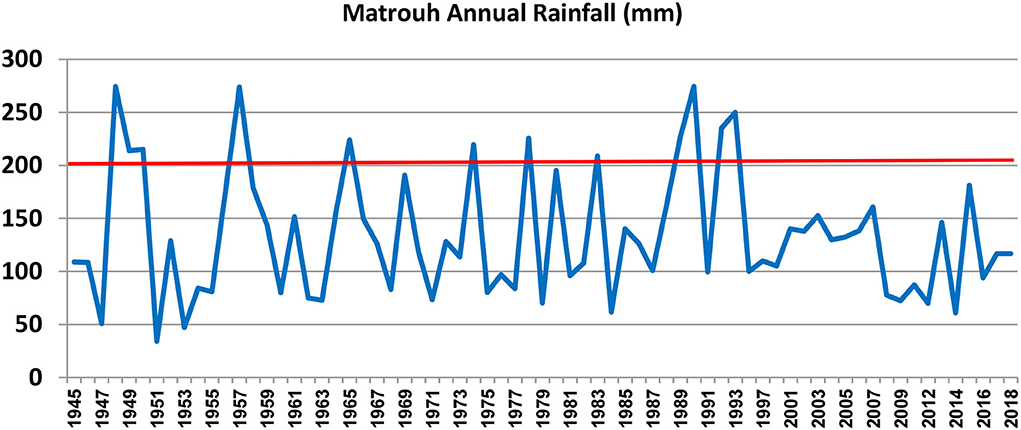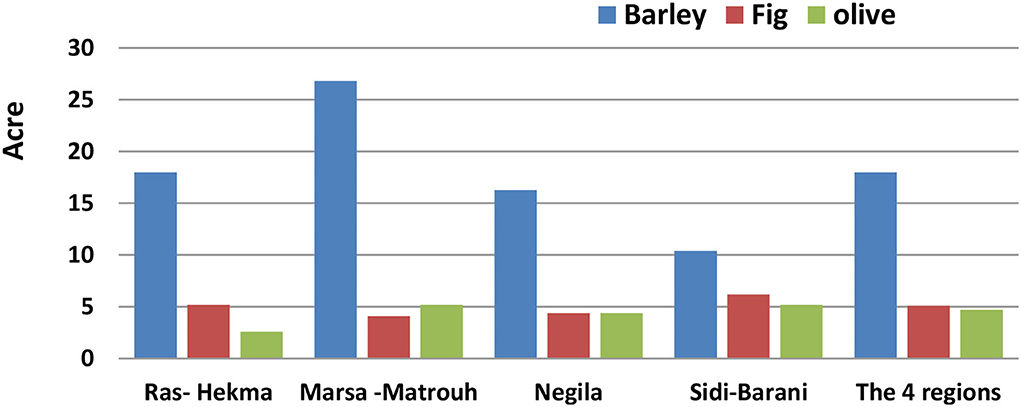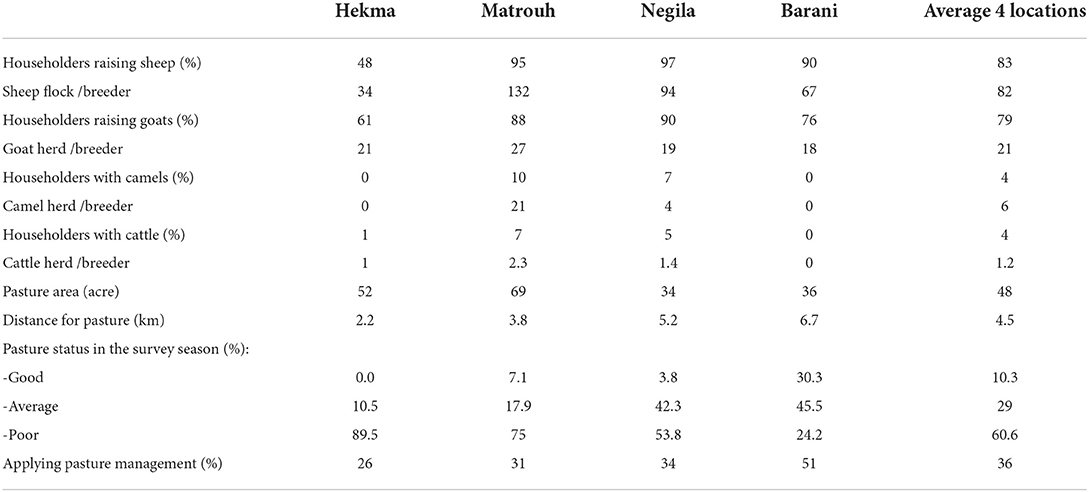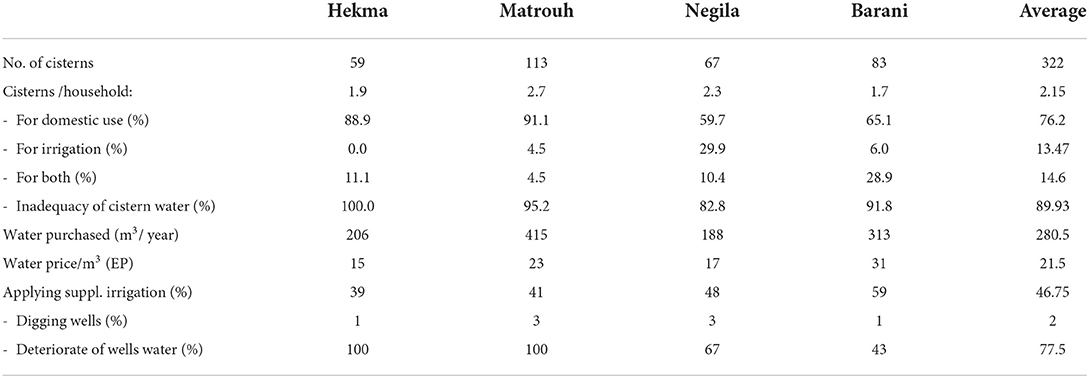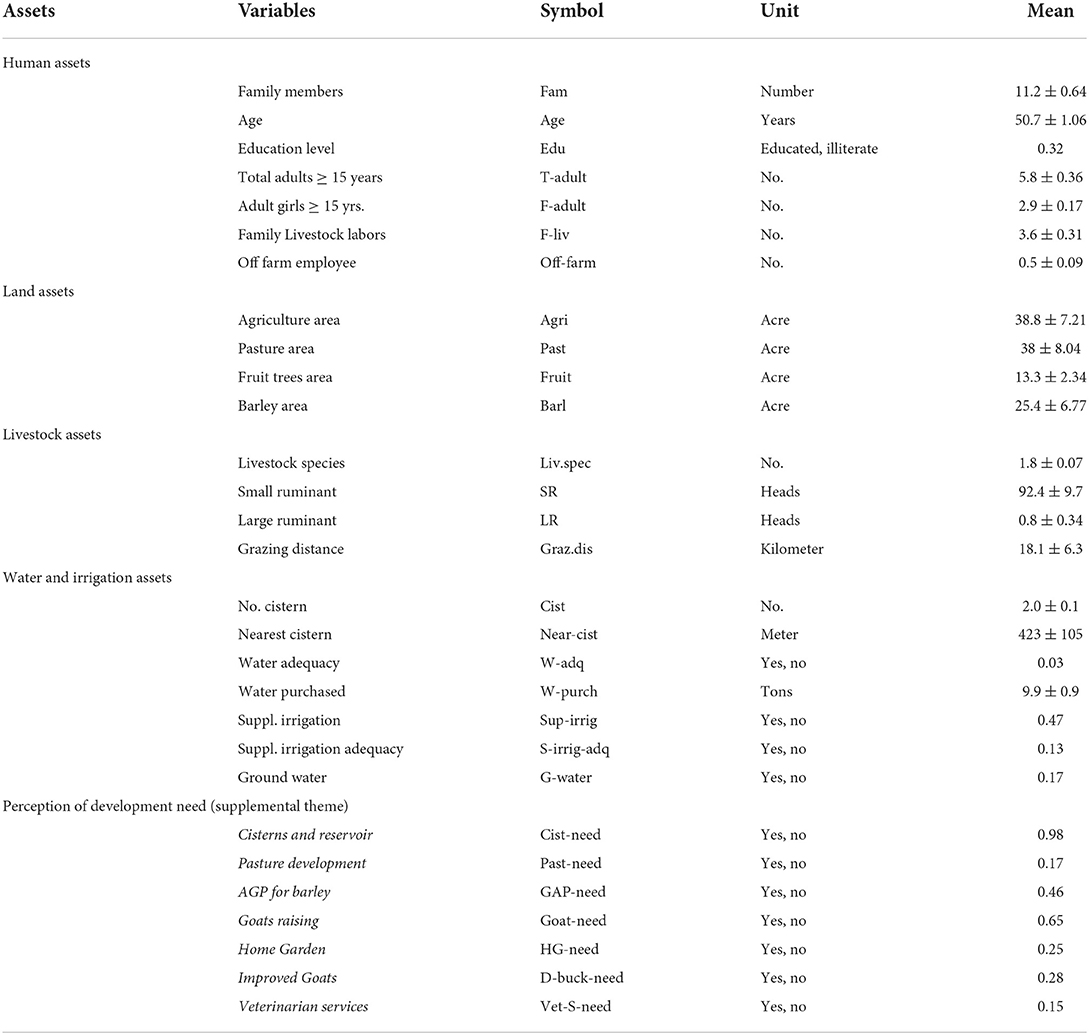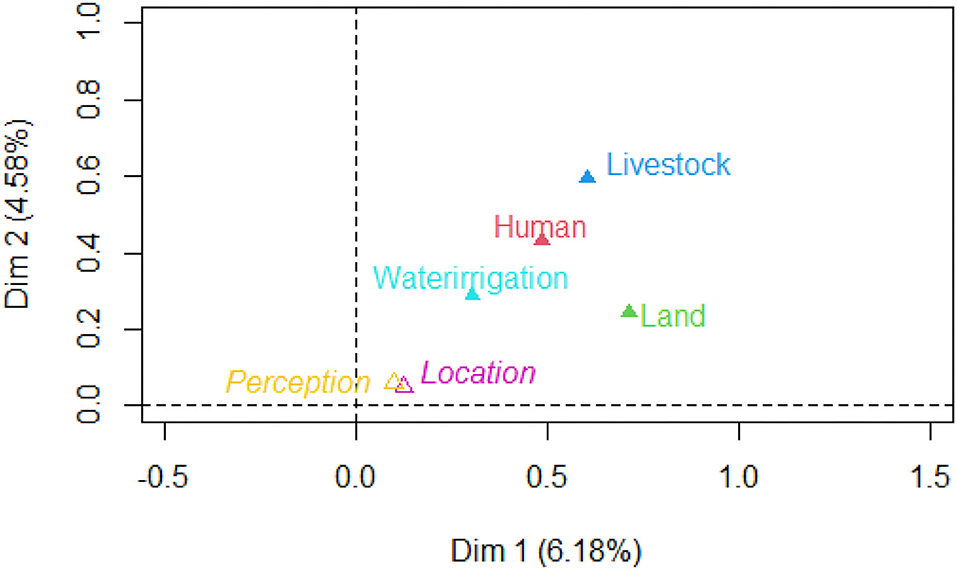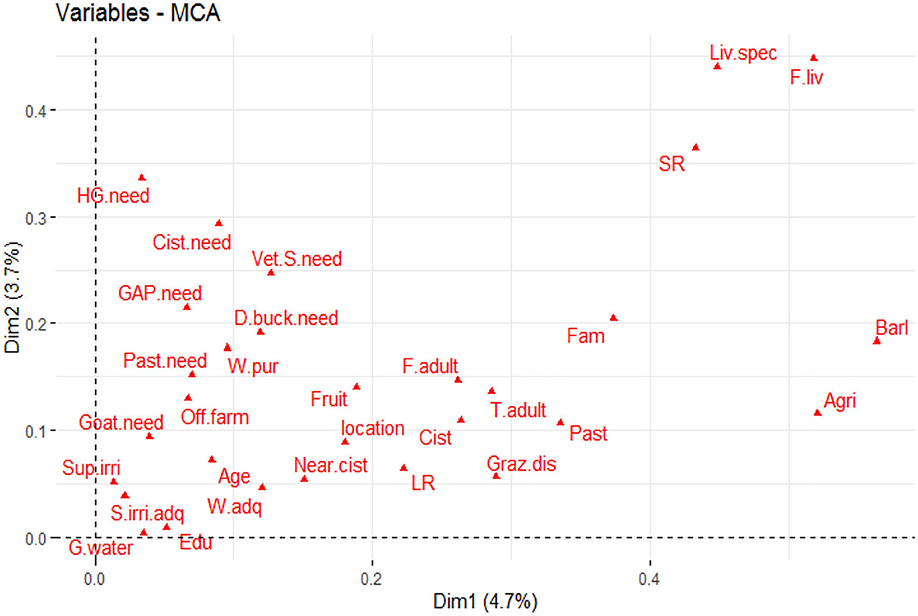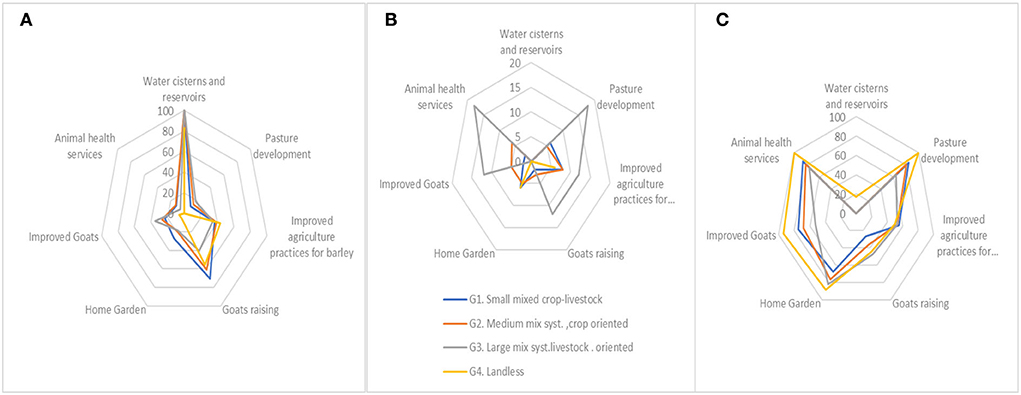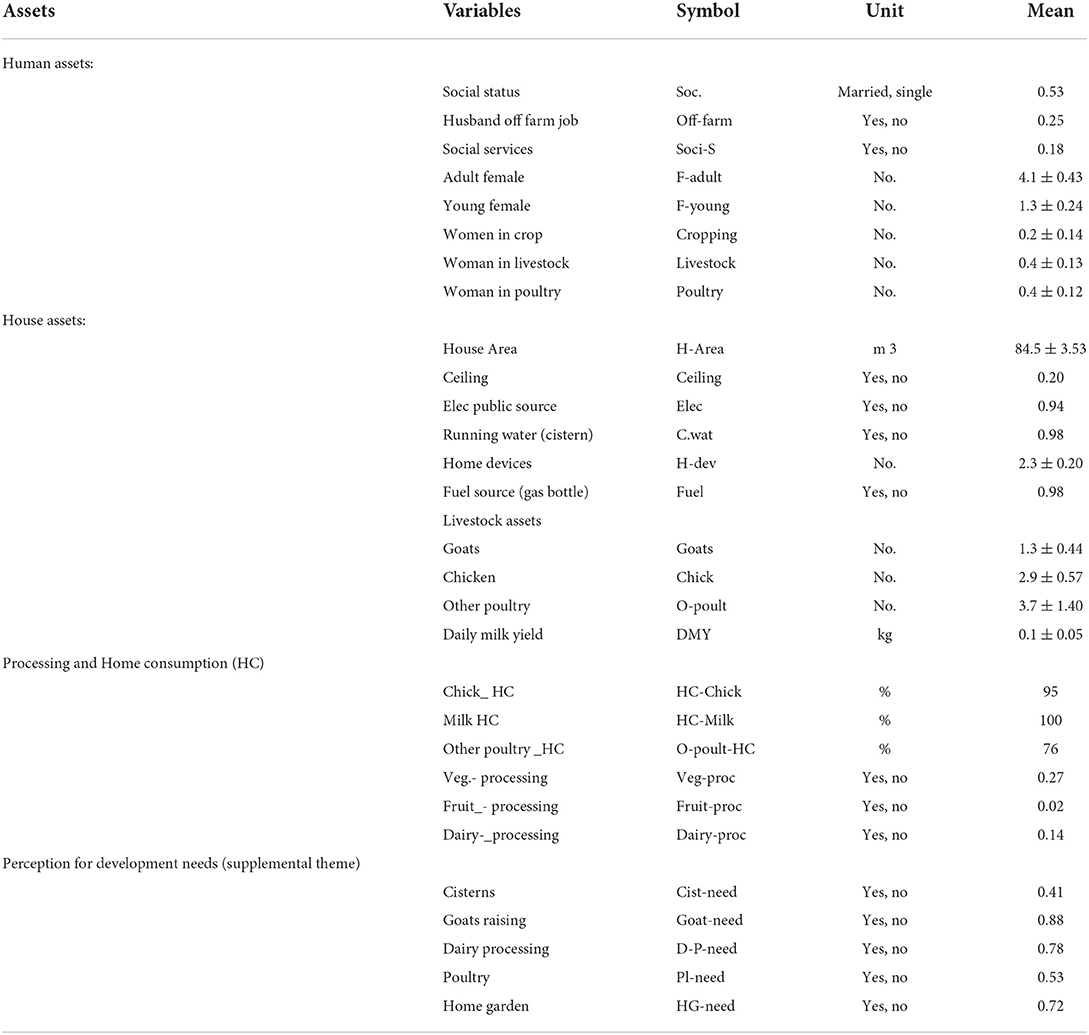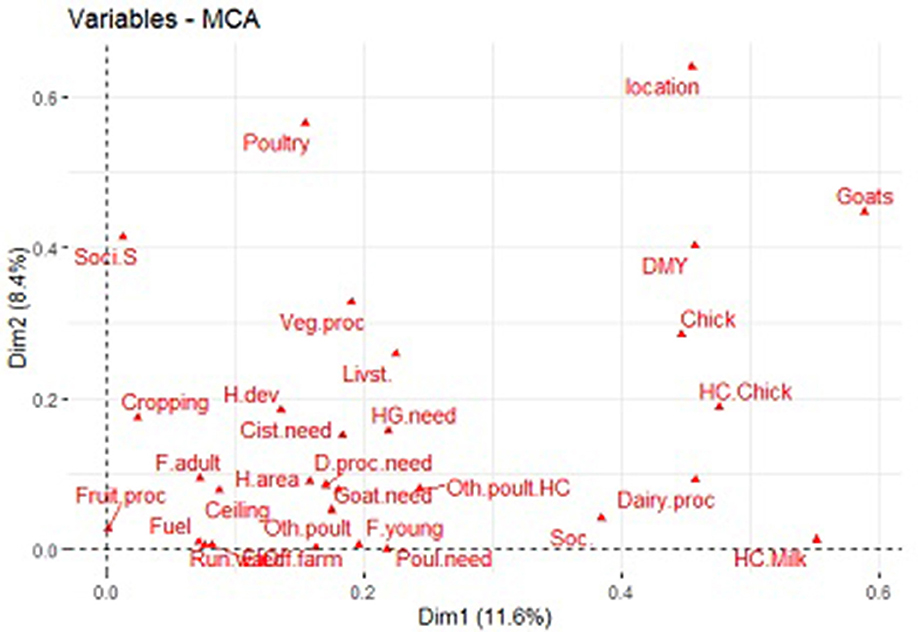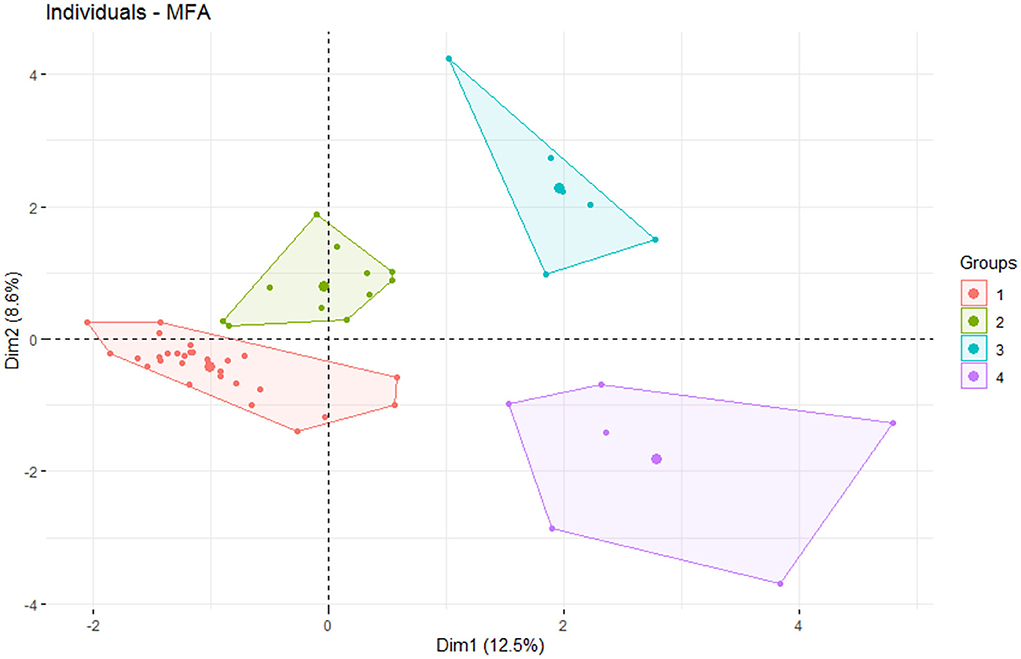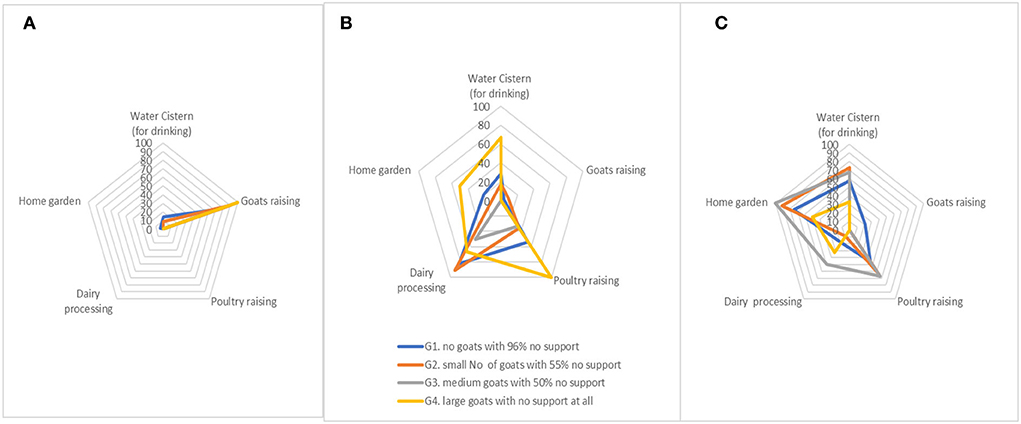Socioeconomic diversity and typology of Bedouin communities in the hot dry Coastal Zone of Western Desert, Egypt
- 1Animal Production Research Institute, Giza, Egypt
- 2Faculty of Agriculture, Ain Shams University, Cairo, Egypt
- 3ICARDA, Tunis, Tunisia
- 4SELMET, CIRAD, INRAE, Institut Agro, Université Montpellier, Montpellier, France
The study was carried out to assess the diversity of the farming system and the associated development needs of Bedouin communities in the rural area of the hot dry Coastal Zone of Western Desert (CZWD), Egypt with the objective of improving surveillance of the Bedouin communities to the harsh desert conditions. The area has low irritated rainfall (60–140 mm/yr.) and frequent incidences of drought. Specially designed questionnaires were adopted on 151 householders and 51 women groups in 4 locations. More than 50% of the householders are fully engaged in agriculture activities, whereas 31% of them are partially engaged in other businesses. The householders are extended families of 12.2 members on average. Gender differences in education are recognizable; 20% of boys ≥15 years of age are illiterate vs. 60% of girls. Dominant agricultural activities of the householders are sheep raising (98.7%), goat raising (89.4%), olive and figs cultivation (84%), and rain-fed barley (78%). Land tenure averages 31.3 acres/ household. Crop cultivation relies on rainfall, 29% of the householders apply supplement irrigation for fruit trees and vegetables. Natural pasture is an important asset for livestock, where small householders do not hold pastureland. Females do not contribute to field cropping, while 53% of them participate in animal husbandry, especially at the house. The typology of the studied stakeholders showed clear diversification in farming systems. They are clustered into four groups; depending mainly on the livestock assets, followed by the land/crop and human assets. Number of species and flock size are the most important variables for the diversity of stakeholders. The cultivated area is the main variable within land/crop assets, family members in livestock and family size are the main variables from human assets. Most of the householders (95%) give their top need for water cisterns, water reservoirs ranked second (78.6%), followed by raising and improving goats. Pasture development got the lowest priority. Goat and poultry rearing, followed by dairy processing got the top needs of women.
Highlights
- The study aims to assess diversity of the farming system and the related development needs for local Bedouin communities,
- Special questionnaires were adopted on 151 householders and 51 women groups in four locations,
- Dominant agricultural activities are sheep and goat raising, olive and figs cultivation, and rain-fed barley,
- Females do not contribute to field cropping, while 53% of them participates in animal husbandry,
- Householders are clustered in four groups, depending mainly on livestock assets, followed by land/crop and human assets,
- Most householders give their top need for water cisterns, followed by goat raising. Goat and poultry plus dairy processing got top needs by women.
Introduction
The Coastal Zone of Western Desert (CZWD) is a hot dry area, located in the western part of Egypt (Matrouh Governorate). It covers 20% of the total area of the country, while it inhabits only 0.4% of the total population (CAPMS, 1997). A vast majority of the citizens are populated on the Mediterranean Sea's coastal strip. Human Development Index (UNDP, 2018) indicated that Matrouh Governorate is one of the least developed governorates in Egypt. It ranked 18th among other governorates and last among the border governorates in economic, health, and education indices. Water resources are the determinant elements for socioeconomic activities, mainly from rainfall and water catchments (cisterns). Agricultural activities (such as barley, figs, and olives) and ranges depend entirely on rainfall, with some supplement irrigation for fruit trees. Marketed products are live animals, olives, and figs. Barley, dairy products, wool, and skins are mainly consumed domestically.
Based on the rainfall data for the past years, rainfall in Matrouh governorate is ≥140 mm. and the largest part falls in October-December. Annual rainfall is subjected to significant fluctuation over the past decades (Figure 1), negatively affecting agricultural activities, pasture status, and consequently, the livelihood of the local Bedouin communities. Matrouh Governorate is considered one of the poorest areas in water resources (AOAD, 2018, 2020) and a weak spot to the expected climatic changes (Aboul-Naga et al., 2021). The rural population is around one-third of the people, compared with 57.6%. of the average of Egypt (CAPMS, 2017). This is directly associated with the poverty of natural resources and lack of job opportunities in the agricultural sector. The rural population tends to decline markedly over the years, being 45% in 2003 and 37% in 2017, reflecting dramatic rural immigration to cities, other parts of the country, and other countries across the Mediterranean.
Economic activities of local communities vary among the coastal strip (5–10 km) and the deep desert areas, urban, and rural areas, and eastern and western regions (Sarhan, 2013; Bonnet et al., 2014). Furthermore, it is diversified seasonally, with intensive summer activities at the shore-strip (beaches), and only small enterprises and services in winter. The problem of minefields (around 17 million mines from World War II) is one of the significant obstacles to the development of the eastern part. Number of development programs has been initiated in the region over the last decades, aiming at settlement and improving the livelihood of the local Bedouin community. Raising sheep and goats is the main socioeconomic activity and source of income in rural areas (Alary et al., 2014). The livestock population in the governorate was estimated at 472 thousand heads in 2017 (MALR, 2018), mainly from sheep and goats, in addition to 18.3 thousand camels and 8.7 thousand cattle. The statistics indicated that the number of sheep and goats increases significantly in the good rainy years and decreases in the drought ones. Their population reached 495 thousand heads in 1995 (235 mm rainfall) and declined to 370 thousand heads in 2015 (62 mm rainfall).
The present study aims to assess the diversity in the socioeconomic indicators of local Bedouin communities in the rural hot dry CZWD and to analyze the links between the family farming system (based on assets) with their developmental and perceived needs, either for the householders or women. The overall objective was to improve the development and policy actions and support under the prevailing hot and desert conditions. Fieldwork was carried out in 2018, supported by “Water harvesting and gap for improving livelihood and increasing sustainable production in rain-fed area of Matrouh”, FAO project, funded by the EU-Joint Rural Development Program.
Materials and methods
The study covers four locations in Matrouh Governorate, representing the main rain-fed areas in the governorate: Ras-Hekma (Hekma), Marsa-Matrouh (Matrouh), Negila, and Sidi-Barani (Barani). Both individual and participatory approaches were adopted for data collection of the socioeconomic indicators for both householders and women and to assess heterogeneity and/or homogeneity in their development needs based on available assets.
A specially designed questionnaire was conducted in 2018 for the socioeconomic assessment of 151 householders, distributed over the four locations according to their rural population (49 in Barani, 42 in Matrouh, 31 in Hekma, and 29 in Negila). The householder's questionnaire includes information on demographic and social indicators of the family householders and its members (such as age, education, and gender), housing and house facilities, agriculture inputs and outputs, crop productivity and revenue, livestock production and natural ranges, and water sources and irrigation.
Another special questionnaire was used to assess the socioeconomic indicators of rural women in the four locations of 51 families (with 155 women); 10 in Hekma, 13 in Matrouh, 10 in Negila, and 18 in Barani. The questionnaire includes information related to women's role in the farm and the house, their contribution to the family income, and involvement in farm and house activities in relation to their development needs.
Need assessments were identified through a participatory approach with householders and women, scoring the priority for each item. The proposed development activities are cistern for domestic use, cistern for supplement irrigation, good agriculture practices for barley, goat improvement, goat raising, rural poultry, dairy processing, fruit and vegetable processing, range shrubs, home garden, and veterinary services.
A cross-sectional analysis was carried out based on multiple factorial analysis (MFA) (Escoffier and Pagés, 1994). Diversity of the householders and women was analyzed separately according to certain assets, each composed of a set of variables, as follows:
• Human assets: family size, age of household family head, education level, adult members, adult females, family laborers, and off-farm employees,
• Land and crop assets: agriculture area, pasture area, fruit trees area, and barley area,
• Livestock assets: livestock species, small ruminants, large ruminants, total livestock unit (TLU), and grazing distance,
• Water and irrigation assets: number of cisterns, distance to cistron, water adequacy, water purchased, and supplementary irrigation.
These sets of variables have been built based on the resilience assessment work of Lasseur et al. (2013), Alary et al. (2016), and Daoud et al. (2016), which highlighted the weight of the structural component such as human, land, livestock, and irrigation as critical components of the overall resilience at the family level. The overall diversity of the stakeholders and women was analyzed by multiple factorial analysis (MFA) followed by a hierarchical clustering analysis (HCA). Perceptions of householders and women for their development needs and location were used as supplemental themes and are not active, so its variables do not participate in the axis. The location was further considered as Supplementary Theme.
Results
Socioeconomic diversity and resilience of householders
Socioeconomic indicators
Human assets
Householders are extended families with 12.2 members (ranged from 15 members in Matrouh to 9.6 in Barani). Heads of household mostly can read and write. Family members ≤ 15 years old in education is 74.7% of boys and 66.7% of girls. The gender gap in education is high among family members over 15 years.; the illiterate rate is 20.1% for men and 60.1% for women, with significant location variations. Head of household family average 50 years. More than 50% of them are fully engaged in agriculture, especially livestock activities, whereas 32% are partially engaged in other businesses besides agriculture. The rate of off-farm employees differs significantly between locations.
Participation in farm activities: men usually do more than one activity on the farm as needed, with animal husbandry at the top of their activities, followed by cropping and then grazing. For females, 62% of those ≥15 years participate in poultry rearing, followed by goat raising at the house (42%); dairy and food processing are practiced by 29% of them. Off-farm activities are basically for males, females are working in the house. The dominant agricultural activity for the householders is sheep rearing (98.7%), goat rearing (89.4%), olive and fig cultivation (84%), followed by rain-fed barley (78%). Geographical variation in the main agriculture activities is limited; however, there is location specificity for the minor activities, e.g., grapes and watermelon in Barani, and cattle raising and almond in Matrouh.
Housing and house facilities: house area averages 149 m2 per family, and house area/family member is low in Matrouh (11.1 m2/capita) and moderate in Barani (16.3 m2/capita). House ceiling is concrete for 48% of the houses, which rises to 71% in Matrouh, and only 27% in Barani. Most of the houses are connected to the public electricity network, whereas few houses are connected to the public water network in Matrouh. Private and family-shared cisterns are the primary water source for domestic use (90%). Water purchased is an essential source for domestic use in Barani and Hekma.
The mean of mobilization is vital due to the extended distance between householders and the service centers, half the householders have a pick-up or family car. Only 26% have tractors and other agricultural machinery is rarely used. Gas bottles are the primary energy source (35%), few use kerosene or straw, and most of them use more than one source.
Land assets and crops
Land tenure averaged 31.3 acres/household (35.7 in Matrouh and 21.5 in Hekma, Figure 2). The main cultivated crops are barley as animal feed, with some figs and olives trees. 29% of them use supplement irrigation for fruit trees and vegetables. Only 15% applied organic fertilizers regularly for fruit trees and 15% used chemical fertilizers.
Barley cultivation for animal feed averaged 18.0 acres/household, with an average productivity of 2.8 tons/acre. Fig trees averaged 5.1 acres/householder, with low productivity of 750 kg/acre. The area of olives is 4.7 acres/householder, with a productivity of only 660 kg/acre.
Livestock assets
The dominant livestock activity is raising sheep and goats, whereas camel and cattle raising are minor activities. Sheep flocks average 82 heads (132 in Matrouh and 34 in Hekma, Table 1); where goat herd average 21 heads. Pastureland averaged 48 acres/householder and distance to pasture averaged 4.5 km. Pastureland represents a vital asset for livestock activity; however, smallholders do not hold pastureland. Most householders (61%) assessed the pasture status last year as poor. Only 36% of them apply pasture management, i.e., rotational grazing (11%) control grazing time, or control stocking rate (9%), whereas 11% practice more than one mean of pasture management.
Water sources and irrigation assets
Cisterns, as rainfall catchments are the major water source; the studied householders (151) owned 322 cisterns, 77% of them for domestic use, 10% for supplement irrigation, and the rest (13%) are used for both (Table 2). In response to water adequacy, the whelming percent of families (92.7%) stated inadequacy of water for domestic use. Most households (94%) purchased water (300 m3/year). Water prices are, on average, 22 EGP/m3, ranging from 15 to 30 EGP/m3 depending on the source, distance, and season.
With the irregularity in the rainfall, either in quantity or season, a significant number of householders (47.7%) use supplement irrigation for fruit trees and vegetables. This is practiced more in Barani (95%) and the least in Hekma (39%). Two % of the householders dig deep wells for supplement irrigation: most (88%) indicated that water quality deteriorates 1 year after another (increase in salinity), which questions the sustainability of the deep wells as a source of water in the area.
Diversity and typology of householders
The overall diversity of the stakeholders as the link between different sets of assets (human, land/crops, livestock, water, and irrigation) and was found to be based on a combination of land and livestock assets in the first place and second on human assets (Table 3, Figure 3). Overall, the livestock assets are more linked with human and land assets (RV = 0.19) than that with location (RV = 0.12) and water and irrigation (RV = 0.11). However, land assets are also linked with human and water/irrigation assets (RV = 0.17 and 0.15, respectively).
Clustering of the householders (using the Ward method developed by Schielke et al., 2009) shows that differentiation of the householder's farming systems is based first on the flock size of small ruminants (Figure 4). Livestock management is based on the prevailing agro-ecological environment; variables such as flock size, percent of sheep and goats, grazing area, and grazing distance are correlated with livestock assets and family members. The link between livestock diversity and the householders' resilience has the highest value among other assets (RV = 0.29), indicating a significant role of the livestock in the livelihood and resilience of the Bedouin communities under harsh desert conditions.
The studied householders are clustered in four groups mainly based on livestock assets, followed by land and human assets (Figure 5). Variables related to livestock assets (number of species and flock size) are the most important variables contributing to the diversity of stakeholders. At the same time, agriculture area and barley area are the main variables from land assets contributing to the grouping of the householders. Family members in livestock activity and family size are the main diversified variables from the human asset. Group 1 (G1) has the lowest estimates in family size, total adults, adult women, off-farm jobs, and number of small ruminants. On the other hand, Group 2 (G2) is the largest group of householders (49), they have the highest values of family members, family in livestock activity, agricultural land, livestock species, and the number of cistern. The group gathers the best resource-endowed householders. Group 3 (G3) has the smallest agricultural area, fruit trees, and barley area. Group 4 (G4) is a small group of 17 householders, they are the landless smallholders with low family values in livestock activity, pasture area, livestock species, and water purchased. This group is considered the lowest-endowed householders (SM 1).
Need assessment at the household level
Analyzing the needs of the different cluster of smallholders showed that all G1, G2, and G3, and most of G4, select water cisterns and reservoirs as their top priority needs (Figure 6). Most of the householders choose to raise more goats as their second need for increasing their income but not the large breeders. Pasture and home gardens do not get priority by any group (SM 2). Improving agriculture practices for rain-fed barley got low priority for more than 50% of the four clusters. Unexpectedly, animal health services did not get priority needs from ≥80% of the householders.
Socioeconomic performance and diversity for women
Socioeconomic indicators
Fifty-one families were surveyed including 155 girls (≥15 years). Young girls ≤ 15 years old, represent 30% of the women population in the family. Most of the girls ≥15 years old are illiterate (79%) and up to 93.5% in Negila. Young girls enrolled in education averaged 32% (61% in Hekma and down to only 20% in Barani).
Girls ≥15 years of age have limited contribution to field cropping (20%), while ≥50% of them participate in animal husbandry (not grazing) (Table 4), and 65% of them are practicing in rural poultry, usually more than one type of poultry (67% chickens, 23% pigeons, and 10% ducks and turkey). Turkey and pigeons are mainly sold for cash. Goat raising comes next to poultry as a crucial women's activity. Goat raising is carried out by 53% of the women, goat herd averaged 8.6 heads in Hekma and 2.8 in Matrouh, and 64% of the families processed ≥50% of their goats' milk. Fruit processing (olive pickling and fig jam) is practiced mainly in Hekma and Negila.
All women get their house needs of water from private- or family-shared cisterns, plus purchasing water if needed. The contribution of the private cistern to the house needs to be estimated as 42%, while family cisterns contribute 37% of their needs. Purchased water cover 21% of the house needs. Refrigerators and TV are essential items in the daily life of most of the families. 90% of families have more than one electric device. Gas is the primary source of energy for house activity.
Typology and diversity of women
The link between women's assets (human, house, livestock, and home processing/consumption) and their perception of development needs as supplemental themes, are presented in Table 5. The outputs in Figure 7 show that Bedouin women are diverse based on the combination of livestock assets and home processing/consumption activities in the first place and second on human assets. Home processing/consumption is highly linked with the livestock assets (RV = 0.54), followed by human assets (RV = 0.26) and location themes (RV = 0.25). The livestock assets are linked with human assets (RV = 0.28), whereas location is correlated with human and house assets (RV = 0.27 and 0.22, respectively). It is worth noting that such link coefficients are higher than those found in householders.
Clustering the women according to the studied assets identified four groups. The first groups are G1 (28 women) and G2 (13 women), they have no or few heads of goats, and consequently, they do not have dairy processing activities (Figure 8). On the other hand, G4 (six women) rely entirely on goat and rural poultry for their livelihood. Group 3 (G3) is a small group who have few female members and relies on rural poultry for house income.
Need assessment
Women did not give high priority to water cisterns for domestic use (Figures 9 and 10). Almost all women (84%) choose to raise more goats as a source of income and home consumption as the top priority (vs. 62% for householders), and 22% percent of the women prioritized dairy processing (similar to the householders). G4, composed of women with large goats, gives a low priority to poultry rearing, home gardens, and water access. Women and householders gave home gardens a low priority (22%).
Discussion and conclusion
Raising sheep and goats on natural ranges and rain-fed barley, are the main agricultural activities of the local Bedouin communities in the hot dry area and the base source of household income. Variables related to livestock assets (e.g., livestock species, number of small ruminates, etc.) are the householders' most important sources of diversity. The second source of diversity is land assets, followed by human assets. The typology of the householders confirms the weight of flock size as an indicator of farm resilience in hot dry areas (Alary et al., 2022). The wellbeing of local communities is determined by a combination of high values of flock size, family members in livestock activity, livestock species, and the number of cisterns. Poor householders have low values of family members in livestock activity, pasture area, livestock species, flock size, and water purchased. The diversification of agricultural and off-farm activities constitutes a way to survive, where induced better wellbeing is mainly through livestock and human assets (Ashley and Carney, 1999; Duteurtre and Faye, 2009). The present findings confirm that livestock activity is the main pillar for the socioeconomic development of local communities in hot dry areas and their bath way out of poverty (Aboul-Naga et al., 2022).
To improve the livelihood of the whole householder, activities for men and women should lead to joint impact and add value. In this perspective, it is important to consider the multiplicity of the activities, so it is enough to raise their living standard and to get the poor out of poverty. The high priority given by householders for water resources, which determined all livestock and agricultural activities, must be recognized (Hoffet et al., 2012). Understanding the traditional values and governing rules of local communities, especially those related to gender and ethnicity, are crucial for the success of any development activities in remote hot dry, such as desert Bedouin communities.
Data availability statement
The original contributions presented in the study are included in the article/Supplementary material, further inquiries can be directed to the corresponding author.
Ethics statement
Ethical review and approval were not required for the study on human participants in accordance with the local legislation and institutional requirements. Written informed consent from the patients/participants or patients/participants legal guardian/next of kin was not required to participate in this study in accordance with the national legislation and the institutional requirements.
Author contributions
AA-N: designing and coordinating the work. VA: socio-economic interpretation. TA: data analysis. TA-K: householders communication. EA-A and ME: field data collection. FF: women related activity. WM: socio-economic analysis. All authors contributed to the article and approved the submitted version.
Acknowledgments
The authors would like to acknowledge the support of Water harvesting and gap for improving livelihood and increasing sustainable production in rain-fed area of Matrouh, FAO project, EU-Joint Rural Development Program, in field data collection with the overall objective of improving surveillance of local Bedouin communities.
Conflict of interest
The authors declare that the research was conducted in the absence of any commercial or financial relationships that could be construed as a potential conflict of interest.
Publisher's note
All claims expressed in this article are solely those of the authors and do not necessarily represent those of their affiliated organizations, or those of the publisher, the editors and the reviewers. Any product that may be evaluated in this article, or claim that may be made by its manufacturer, is not guaranteed or endorsed by the publisher.
Supplementary material
The Supplementary Material for this article can be found online at: https://www.frontiersin.org/articles/10.3389/fsufs.2022.970999/full#supplementary-material
References
Aboul-Naga, A., Siddik, I., Mogahed, W., Faten, F., Elshafi, M., El-Wakeel, E., et al. (2022). Livestock development, pillar for improving livelihood of Bedouin communitiesin the hot dry area of Coastal Zone Western Desert, Egypt. E.J. Anim. Prod. 59, 3. (in press)
Aboul-Naga, A. M., Abdel halik, T. M., Osman, M. A., Elbeltagy, A. R., Abdel-Aal, E. S., Abou-Ammo, F. F., et al. (2021). Physiological and genetic adaptation of desert sheep and goats to heat stress in the arid areas of Egypt. Small Rumin. Res. 203, 106499. doi: 10.1016/j.smallrumres.2021.106499
Alary, V., Lasseur, J., Frija, A., and Gautier, D. (2022). Assessing the sustainability of livestock socio-ecosystems in the drylands through a set of indicators. Agri. Syst. 198, 103389. doi: 10.1016/j.agsy.2022.103389
Alary, V., Messad, S., Aboul-Naga, A., Osman, M. A., Daoud, I., Bonnet, P., et al. (2014). Livelihood strategies and the role of livestock in the processes of adaptation to drought in the Coastal Zone of Western Desert (Egypt). Agri. Syst. 128, 44–54 doi: 10.1016/j.agsy.2014.03.008
Alary, V., Messad, S., Daoud, I., Aboul-Naga, A., Osman, M. A., Bonnet, P., et al. (2016). Social network and vulnerability: a clear link in Bedouin society (Egypt). Human ecology. 44, 81–90. doi: 10.1007/s10745-016-9807-z
AOAD (2018). Yearbook of Arab Agricultural Statistics,The Arab Organization for Agricultural Development, Chapter Two, “Rain”, miscellaneous issues.”
AOAD (2020). “Baseline study of target landscapes under HERD “Egypt”, Northwestern coast, Matrouh Governorate, Egypt Abou Mazhoud and Al-Gaaween Areas”, in Arab Organization for Agriculture Development report for CEDARE, Rizk, R.
Ashley, C., and Carney, D. (1999). Sustainable Livelihoods: Lessons From Early Experience, vol. 7(1). London: Department for International Development. Google Scholar.
Bonnet, P., Alary, V., Aboulnaga, A. M., Daoud, I., Fawzi, A. K., Saidi, S., et al. (2014). Atlas of changes in livestock farming systems, livelihoods and landscapes of the Northwest coast of Egypt. Montpellier: CIRAD,-APRI. p. 64. Available online at: http://elvulmed.cirad.fr/FichiersComplementaires/Atlas_Egypt_Ver-8.pdf
CAPMS (1997). General Census of Population, Housing and Establishments. Central Agency for Public Mobilization and Statistics, Cairo, Egypt.
CAPMS (2017). General Census of Population, Housing and Establishments. Central Agency for Public Mobilization and Statistics, Cairo, Egypt.
Daoud, I., Osman, M. A., Alary, V., Moselhy, N., Salah, E., Aboul Naga, A, et al. (2016). “Adaptation and resilience in pastoral management of the Mediterranean Bedouin social–ecological system in the northwestern coastal zone of Egypt,” in Building Resilience of Human-Natural Systems of Pastoralism in the Developing World. Cham: Springer. p. 209–250. doi: 10.1007/978-3-319-30732-9_6
Duteurtre, G., and Faye, B. (2009). Lélevage, richesse des pauvres. Versailles (France): Quæ. Cross Ref Google Scholar. doi: 10.3917/quae.duteu.2009.01
Escoffier, B., and Pagés, J. (1994). Multiple factor analysis (AFMULT package). Comput. Stat. Data Anal. 18, 121–140. doi: 10.1016/0167-9473(94)90135-X
Hoffet, N., Daoud, I., Alary, V., Tourrand, J. F., and Moselhy, N. (2012). Participation, Power and Sustainable Water Resource Management, A Case Study of the Rainfed Desert Region of Matruh, Egypt. IFSA.
Lasseur, J., Alary, V., Aboul-Naga, A., Bonnet, P., and Tourrand, J. F. (2013). Adaptability of Small Ruminant Farming Facing Global Change. A north south analysis in Mediterranea. Wageningen: Wageningen Academic Publishers.
MALR (2018). Livestock Bulletin, Ministry of Agriculture and Land Reclamation, Economic Affairs Sector. Ministry of Agriculture, Cairo, Egypt.
Sarhan, M. (2013). The socioeconomic assessment,Siwa Oasis, Red sea area, and Matrouh governate in Egypt, UNDP technical Report. UNDP Cairo Office.
Schielke, H. J., Fishman, J. L., Osatuke, K., and Stiles, W. B. (2009). Creative consensus on interpretations of qualitative data: the Ward method. Psychother Res. 19, 558–65.
Keywords: socioeconomic, typology, Bedouin, hot dry, Egypt
Citation: Aboul-Naga AM, Mogahed W, Fahmy F, Elshafi M, Abdel-Aal ES, Abdel-khalek T, Abdelsabour TH and Alary V (2022) Socioeconomic diversity and typology of Bedouin communities in the hot dry Coastal Zone of Western Desert, Egypt. Front. Sustain. Food Syst. 6:970999. doi: 10.3389/fsufs.2022.970999
Received: 16 June 2022; Accepted: 14 October 2022;
Published: 11 November 2022.
Edited by:
Andrea Pieroni, University of Gastronomic Sciences, ItalyReviewed by:
Ibrahim Siddik Aly, University of Menoufia, EgyptIngvar Svanberg, Uppsala University, Sweden
Copyright © 2022 Aboul-Naga, Mogahed, Fahmy, Elshafi, Abdel-Aal, Abdel-khalek, Abdelsabour and Alary. This is an open-access article distributed under the terms of the Creative Commons Attribution License (CC BY). The use, distribution or reproduction in other forums is permitted, provided the original author(s) and the copyright owner(s) are credited and that the original publication in this journal is cited, in accordance with accepted academic practice. No use, distribution or reproduction is permitted which does not comply with these terms.
*Correspondence: Adel M. Aboul-Naga, adelmaboulnaga@gmai.com
 Adel M. Aboul-Naga
Adel M. Aboul-Naga Waheed Mogahed2
Waheed Mogahed2  Taha H. Abdelsabour
Taha H. Abdelsabour Veronique Alary
Veronique Alary